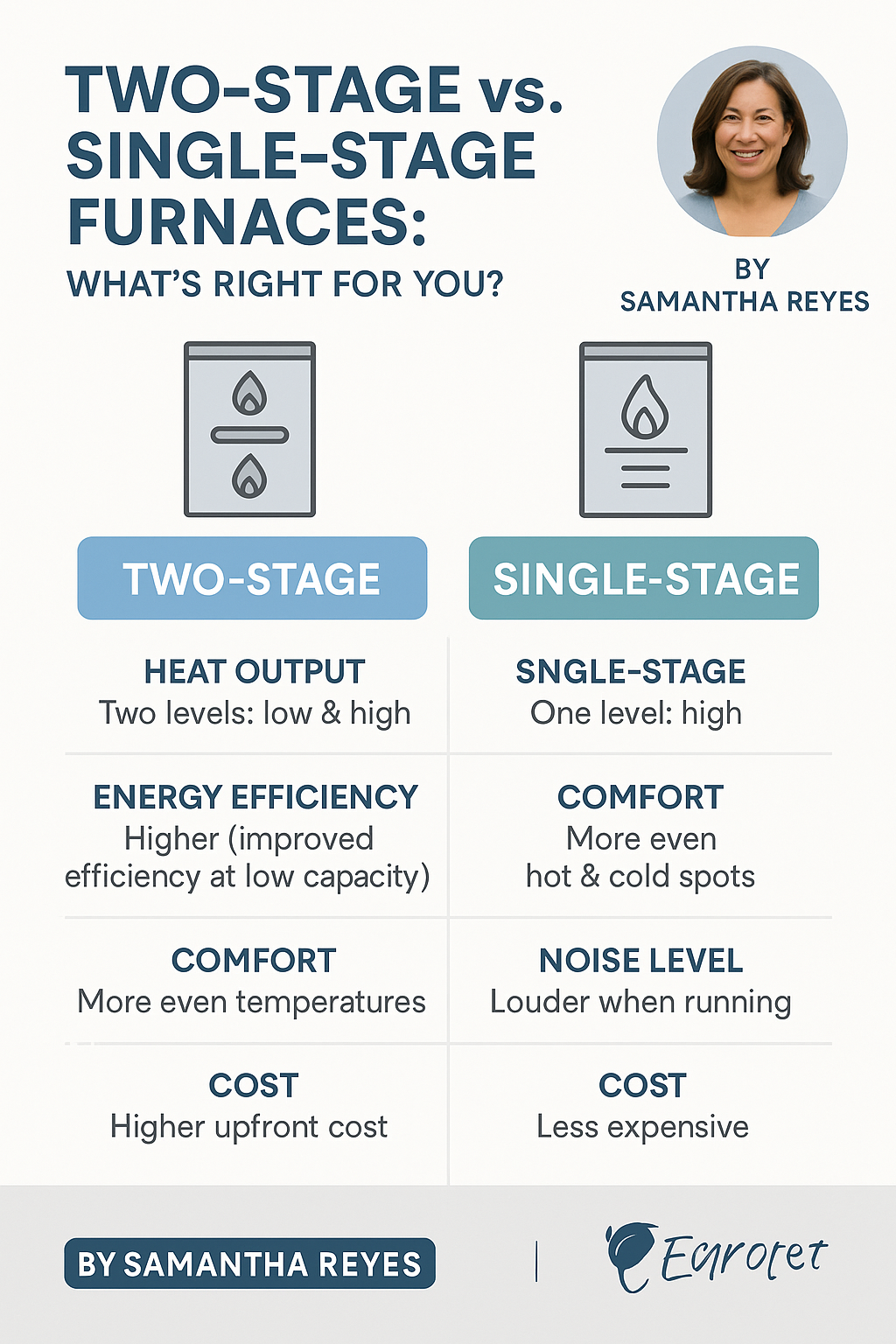👋 Hello from Samantha
Hi there! I’m Samantha Reyes, your home comfort expert from The Furnace Outlet. One of the most common questions I get from homeowners shopping for a new heating system is:
“What’s the difference between a two-stage and a single-stage furnace—and does it really matter?”
Yes, it does! And I’m here to walk you through what that means, why it matters, and how to decide which type is best for your home and lifestyle.
🧠 The Basics: What Are Furnace Stages?
Before diving into comparisons, let’s define what staging in a furnace actually means.
🔹 Single-Stage Furnace:
A single-stage furnace has one heating output level: full blast. When it’s on, it runs at 100% capacity until the thermostat setting is reached, then shuts off. It's either on or off, like a light switch.
🔹 Two-Stage Furnace:
A two-stage furnace has two heating levels:
-
Low-stage (~65–70% capacity) for milder days
-
High-stage (100% capacity) for very cold days
It starts on the low setting and only ramps up if needed, providing more even heat, better efficiency, and quieter operation.
🔍 Real-Life Analogy
Think of a single-stage furnace like driving in only one gear—say, fifth gear. It’s fast but rough and fuel-intensive. A two-stage furnace, in contrast, uses first gear when it doesn’t need to floor it and shifts to fifth when needed.
It’s a smoother, smarter way to heat your home.
💡 Key Differences: Single-Stage vs. Two-Stage
Here’s how the two compare in critical areas:
| Feature | Single-Stage | Two-Stage |
|---|---|---|
| Heat Output | One level (100%) | Two levels (~65% and 100%) |
| Energy Efficiency | Lower | Higher (especially in part-load conditions) |
| Comfort | Temperature swings | More consistent temps |
| Noise Level | Louder | Quieter (runs longer at low speed) |
| Cost | Lower upfront | Higher upfront, but savings over time |
| Lifespan | Shorter cycle life | Longer equipment life (fewer stops/starts) |
🏡 Which Furnace Is Right for Your Home?
Let’s explore when each type makes sense.
✅ Choose a Single-Stage Furnace if:
-
You live in a mild climate and don’t run heat all day.
-
You’re replacing a system in a rental or flip property.
-
You’re on a tight budget and want the lowest upfront cost.
-
You’re fine with occasional temperature swings.
While these furnaces lack finesse, they’re tried-and-true workhorses—especially when paired with a smart thermostat for better control.
✅ Choose a Two-Stage Furnace if:
-
You live in a colder climate with long heating seasons.
-
You want quieter, more even heating throughout the home.
-
You care about indoor air quality—longer run times mean better filtration.
-
You want energy savings and possibly qualify for rebates.
Two-stage systems are especially beneficial in homes with multiple floors, where temperature differences can be dramatic.
💬 Samantha’s Field Tip:
“If your current single-stage furnace feels like it’s blasting heat then going silent, you’ll love the balanced warmth of a two-stage model like the Goodman GR9T801205DN. It’s quieter, more comfortable, and just plain smarter.”
🌡️ Comfort in Action: A Scenario Comparison
Let’s imagine a 35°F day in Chicago.
-
🔥 Your single-stage furnace turns on full blast, heats your home quickly, then shuts off. Twenty minutes later, the home cools slightly and it kicks on again. You get hot and cold zones, and a louder furnace cycling on and off.
-
🔥 Your two-stage furnace turns on at low stage, gradually warms the house, and runs longer at a low speed—keeping temperatures steady and quiet throughout the house. You feel cozy without the roller coaster.
💸 Cost Breakdown: Upfront vs. Lifetime
| Category | Single-Stage | Two-Stage |
|---|---|---|
| Purchase Price | $1,500–$2,500 | $2,000–$3,500 |
| Installation | Lower (basic setup) | Higher (requires more controls) |
| Operating Cost | Higher due to on/off cycling | Lower due to energy efficiency |
| Estimated Annual Savings | — | $100–$300/year (climate-dependent) |
| Rebates Available? | Often No | Yes (incentives for ENERGY STAR) |
External Source: For rebate info, visit Energy Star HVAC Rebates.
🔄 Compatibility with Smart Thermostats
Both systems can work with smart thermostats, but two-stage furnaces need two-stage-compatible thermostats to function optimally. Many models, like the Ecobee Smart Thermostat Premium or Nest Learning Thermostat, are perfect for this.
External Link: Check this helpful guide from Ecobee on furnace compatibility.
⚙️ Two-Stage Furnace + ECM Motors = Game-Changer
Most modern two-stage furnaces pair with ECM (Electronically Commutated Motors) or variable-speed blowers, offering:
-
More precise airflow control
-
Even quieter operation
-
Reduced energy use (especially for AC in summer)
-
Better humidity control
If you’re considering a Goodman two-stage model like the GR9T801205DN, this combo is standard—and worth it!
🔎 Maintenance Differences
Single-Stage:
-
Shorter run times = more cycling, leading to faster wear.
-
Less airflow time = poorer filtration.
-
Simpler design = easier repairs.
Two-Stage:
-
Longer cycles = less start-stop stress.
-
Better airflow = cleaner air.
-
More parts = higher repair costs, but less frequent.
External Resource: For details on furnace maintenance costs, read this detailed breakdown from HomeAdvisor.
🌎 Environmental Impact
Two-stage furnaces are more eco-friendly:
-
Lower emissions
-
More efficient fuel use
-
Quieter operation reduces noise pollution
If sustainability matters to you, this should weigh heavily in your decision.
🔚 Final Thoughts: Samantha’s Takeaway
If you're in a mild climate or on a tight budget, a single-stage furnace might suit you just fine. But if you're like many of the homeowners I work with who want better comfort, energy savings, and quiet operation, a two-stage model is worth the upgrade.
Especially when bundled with a quality smart thermostat and installed by a reputable team, it’s a long-term win for your wallet—and your peace of mind.
In the next topic we will read about: Do You Need 120,000 BTUs? A Homeowner's Guide to Furnace Sizing - By Samantha Reyes, Home Comfort Advisor







